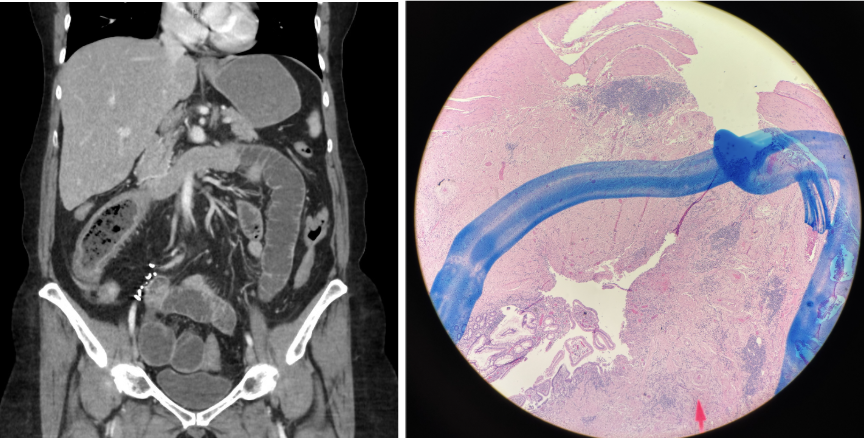Tuesday Poster Session
Category: Small Intestine
P6224 - Rare Etiology of Small Bowel Obstruction in Crohn's Disease: A Case of Endosalpingiosis
Tuesday, October 28, 2025
10:30 AM - 4:00 PM PDT
Location: Exhibit Hall

Se Yeon Kim, DO (she/her/hers)
Henry Ford Health Genesys Hospital
Grand Blanc, MI
Presenting Author(s)
Award: ACG Presidential Poster Award
Se Yeon Kim, DO1, Ali-Hamza Ramzan, DO1, Danielle Nash, DO2, Justin Miller, DO1
1Henry Ford Health Genesys Hospital, Grand Blanc, MI; 2Henry Ford Health Genesys Hospital, Holly, MI
Introduction: Small bowel obstruction (SBO) is a well-recognized complication of Crohn’s disease, with strictures accounting for up to 54% of cases. By contrast, endosalpingiosis (ES) is a rare and poorly understood condition defined as the presence of endothelial cells resembling fallopian tube epithelium found outside the fallopian tubes. Although usually considered a benign finding, emerging evidence points to its potential clinical significance, particularly concerning gynecologic malignancies and gastrointestinal involvement. We present an interesting case of SBO in a patient with Crohn’s disease caused by an ES-induced stricture, an association not previously reported in the literature.
Case Description/
Methods: A 69-year-old woman with a long-standing history of fistulizing Crohn’s disease on mesalamine presented with right lower quadrant pain. CT imaging revealed a high-grade distal SBO near the ileocecal valve. Due to worsening symptoms, the patient underwent exploratory laparotomy with ileocecal resection and right hemicolectomy. Histologic examination of the resected specimen revealed focal areas of mucosal ulceration with fissuring, consistent with Crohn’s disease. Yet, most of the resected bowel was without evidence of active Crohn’s disease. Interestingly, there were numerous glandular inclusions embedded within the muscularis propria, which were lined by a single layer of bland-appearing columnar and ciliated columnar epithelium, closely resembling that of the fallopian tube. Immunohistochemical staining was consistent with müllerian-derived epithelium, supporting ES as the underlying cause of the stricture.
Discussion: Although ES is not inherently inflammatory, its presence within the gastrointestinal tract may lead to complications such as fibrosis and adhesion, especially in patients with other comorbidities such as Crohn's disease. In our case, histopathologic examination of the ileocecal stricture revealed intramural ES with only minimal evidence of active inflammatory bowel disease. This finding suggests that the SBO was primarily driven by ES-related fibrosis or mass effect rather than Crohn’s disease. To our knowledge, this is the first reported case of SBO due to ES in the context of Crohn’s disease, highlighting a previously unrecognized overlap between these two distinct conditions.

Figure: Figure 1: Contrast-enhanced CT of the abdomen and pelvis revealed a high-grade small bowel obstruction near the ileocecal valve.
Figure 2: Histologic evaluation of the ileocecal stricture revealed focal mucosal ulceration with fissuring, findings consistent with Crohn’s disease.

Figure: Figure 3: Histologic evaluation of the ileocecal stricture demonstrates Paired Box 8 (PAX8) positivity, a marker commonly expressed in a female genital tract origin.
Figure 4: Histologic evaluation of the ileocecal stricture demonstrates positive staining for estrogen receptor (ER), a marker commonly expressed in a female genital tract origin.
Figure 5: Histologic evaluation of the ileocecal stricture shows negative staining for villin, indicating a lack of gastrointestinal epithelial differentiation.
Disclosures:
Se Yeon Kim indicated no relevant financial relationships.
Ali-Hamza Ramzan indicated no relevant financial relationships.
Danielle Nash indicated no relevant financial relationships.
Justin Miller indicated no relevant financial relationships.
Se Yeon Kim, DO1, Ali-Hamza Ramzan, DO1, Danielle Nash, DO2, Justin Miller, DO1. P6224 - Rare Etiology of Small Bowel Obstruction in Crohn's Disease: A Case of Endosalpingiosis, ACG 2025 Annual Scientific Meeting Abstracts. Phoenix, AZ: American College of Gastroenterology.
Se Yeon Kim, DO1, Ali-Hamza Ramzan, DO1, Danielle Nash, DO2, Justin Miller, DO1
1Henry Ford Health Genesys Hospital, Grand Blanc, MI; 2Henry Ford Health Genesys Hospital, Holly, MI
Introduction: Small bowel obstruction (SBO) is a well-recognized complication of Crohn’s disease, with strictures accounting for up to 54% of cases. By contrast, endosalpingiosis (ES) is a rare and poorly understood condition defined as the presence of endothelial cells resembling fallopian tube epithelium found outside the fallopian tubes. Although usually considered a benign finding, emerging evidence points to its potential clinical significance, particularly concerning gynecologic malignancies and gastrointestinal involvement. We present an interesting case of SBO in a patient with Crohn’s disease caused by an ES-induced stricture, an association not previously reported in the literature.
Case Description/
Methods: A 69-year-old woman with a long-standing history of fistulizing Crohn’s disease on mesalamine presented with right lower quadrant pain. CT imaging revealed a high-grade distal SBO near the ileocecal valve. Due to worsening symptoms, the patient underwent exploratory laparotomy with ileocecal resection and right hemicolectomy. Histologic examination of the resected specimen revealed focal areas of mucosal ulceration with fissuring, consistent with Crohn’s disease. Yet, most of the resected bowel was without evidence of active Crohn’s disease. Interestingly, there were numerous glandular inclusions embedded within the muscularis propria, which were lined by a single layer of bland-appearing columnar and ciliated columnar epithelium, closely resembling that of the fallopian tube. Immunohistochemical staining was consistent with müllerian-derived epithelium, supporting ES as the underlying cause of the stricture.
Discussion: Although ES is not inherently inflammatory, its presence within the gastrointestinal tract may lead to complications such as fibrosis and adhesion, especially in patients with other comorbidities such as Crohn's disease. In our case, histopathologic examination of the ileocecal stricture revealed intramural ES with only minimal evidence of active inflammatory bowel disease. This finding suggests that the SBO was primarily driven by ES-related fibrosis or mass effect rather than Crohn’s disease. To our knowledge, this is the first reported case of SBO due to ES in the context of Crohn’s disease, highlighting a previously unrecognized overlap between these two distinct conditions.

Figure: Figure 1: Contrast-enhanced CT of the abdomen and pelvis revealed a high-grade small bowel obstruction near the ileocecal valve.
Figure 2: Histologic evaluation of the ileocecal stricture revealed focal mucosal ulceration with fissuring, findings consistent with Crohn’s disease.

Figure: Figure 3: Histologic evaluation of the ileocecal stricture demonstrates Paired Box 8 (PAX8) positivity, a marker commonly expressed in a female genital tract origin.
Figure 4: Histologic evaluation of the ileocecal stricture demonstrates positive staining for estrogen receptor (ER), a marker commonly expressed in a female genital tract origin.
Figure 5: Histologic evaluation of the ileocecal stricture shows negative staining for villin, indicating a lack of gastrointestinal epithelial differentiation.
Disclosures:
Se Yeon Kim indicated no relevant financial relationships.
Ali-Hamza Ramzan indicated no relevant financial relationships.
Danielle Nash indicated no relevant financial relationships.
Justin Miller indicated no relevant financial relationships.
Se Yeon Kim, DO1, Ali-Hamza Ramzan, DO1, Danielle Nash, DO2, Justin Miller, DO1. P6224 - Rare Etiology of Small Bowel Obstruction in Crohn's Disease: A Case of Endosalpingiosis, ACG 2025 Annual Scientific Meeting Abstracts. Phoenix, AZ: American College of Gastroenterology.


